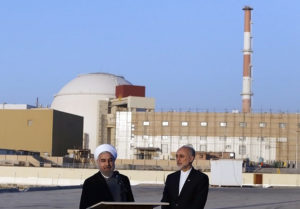 By Samuel M. Hickey
By Samuel M. Hickey
On May 27, Secretary of State Mike Pompeo announced that the United States will now block the efforts of Russia, China and some European countries to make it harder for Iranian nuclear sites to be used for weapons development. By threatening to sanction our partners and allies who are constraining Iran’s nuclear program, the Trump Administration is effectively daring Iran to move toward a nuclear weapons capability.
The Trump Administration has decided it will not extend three sanctions waivers for work at three Iranian nuclear sites. One additional waiver for work at another Iranian nuclear site was extended for 90 days but may not be extended again.
Since the Trump Administration’s withdrawal from the Joint Comprehensive Plan of Action (JCPOA) over two years ago, Iran hawks like Sen. Ted Cruz have fought to prevent the renewal of four nuclear waivers in order to eviscerate the last remnants of the “catastrophic Obama-Iran nuclear deal.” The Trump Administration had begrudgingly countered that certain nuclear projects were restrained by the nuclear deal and the work must continue.
Under the waivers, the United States agreed not to sanction any companies in relation to four activities:
1) Transfer fuel to the Tehran Research Reactor (TRR)
2) Transfer of spent nuclear fuel out of Iran
3) Modification of the Arak heavy water research reactor
4) Activities at the Bushehr reactor, including fueling
On the first waiver, the TRR is fueled by 20% enriched uranium, but under the JCPOA Iran is not allowed to enrich (or concentrate) uranium above 3.67%. By blocking this transfer, the Trump Administration gives Iran political cover to enrich to this much higher level to fuel the TRR. Iran is already enriching uranium slightly higher than allowed (approximately 5%) in response to the Trump Administration’s withdrawal from the nuclear deal and imposition of crippling sanctions, but 20% would be a serious escalation. At 20% purity, Iran is most of the way to achieving weapons-grade fissile material for a nuclear bomb.
On the second waiver, the JCPOA required Iran to ship spent nuclear fuel out of the country and Iran has done so. Now, Iran will be forced to accumulate a stockpile of irradiated fuel that could be reprocessed to retrieve plutonium. It is estimated that the TRR can produce about 1/10th of the plutonium needed for a Nagasaki bomb annually. Preventing reprocessing by Iran was a top objective in the JCPOA negotiations, since all nine countries with nuclear weapons have produced and separated plutonium for weapons.
The third waiver allowed China to modify the Arak reactor under the supervision of the United Kingdom, but Iran could still revert back to the original design. If that happens, the Arak reactor could produce sufficient fuel for one or two nuclear weapons per year.
The fourth waiver will be extended so that Russia can “help ensure the safety of operations” at the Bushehr nuclear power plant. Russia already delivered the 2020 supply of fuel and Iran is presently loading it into the reactor. Iran will not need another delivery of fuel for the next 18 months, but it seems the United States is hesitant to threaten Russia’s commercial interests since the reactor is strictly peaceful.
Removing the shackles on Iran’s nuclear program
It remains to be seen if either Russia or China will be willing to flout U.S. sanctions and assist Iran with its nuclear program, although it is very unlikely. Both countries have their own relationships with the United States to manage and the global economy has taken a nosedive due to the COVID-19 pandemic.
Russia, China and the European countries have already failed to provide Iran economic or humanitarian relief. The Instrument in Support of Trade Exchanges (INSTEX), the European effort to bypass U.S. sanctions, has only processed one transaction; the Swiss humanitarian channel has not processed any transactions since January and the Coronavirus has run roughshod over Iran’s failing healthcare system.
Iran is not likely to bow to U.S. pressure and is left with few peaceful ways to regain leverage. By increasing its level of enrichment to fuel the TRR, accumulating a greater stockpile of uranium in a brinksmanship strategy or returning the Arak reactor to its original design, the Iranians could hope to scare some countries into pushing for relief. However, these tactics would validate the Trump Administration’s contention that Iran was always going to pursue a nuclear weapon when the full slate of JCPOA restrictions expired in 2030. That may not matter to leaders in Tehran who could continue to increase tensions as we near the U.S. 2020 presidential election.
